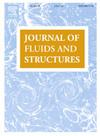Stress relaxation and thermo-visco-elastic effects in fluid-filled slits and fluid-loaded plates
IF 3.4
2区 工程技术
Q1 ENGINEERING, MECHANICAL
引用次数: 0
Abstract
In this paper, we theoretically analyse wave propagation in two canonical problems of interest: fluid-filled thermo-visco-elastic slits and fluid-loaded thermo-visco-elastic plates. We show that these two configurations can be studied via the same pair of dispersion equations with the aid of the framework developed in García Neefjes et al. (2022), which incorporates thermal effects. These two problems are further interrelated, since in the short wavelength limit (relative to the slit/plate width) the respective modes are governed by the same dispersion equation, commonly known as the Scholte–Stoneley equation. It is the Scholte-type modes that are mainly analysed in this paper. We illustrate results when the fluid is water, although the theory is valid for any Newtonian fluid. Both ‘hard’ and ‘soft’ solids are compared, with the emphasis being placed on the importance of thermo-viscoelastic effects, particularly when stress relaxation is considered. Two main recent works are discussed extensively, namely (Cotterill et al., 2018) for slits and (Staples et al., 2021) for loaded plates, both of which do not incorporate viscoelastic mechanisms. We show how the consideration of viscoelasticity can extend the results discussed therein, and explain the circumstances under which they arise.
充满流体的狭缝和流体负载板中的应力松弛和热粘弹效应
在本文中,我们从理论上分析了波在两个典型问题中的传播:充满流体的热粘弹性狭缝和充满流体的热粘弹性板。我们表明,借助加西亚-尼夫杰斯等人(2022 年)所开发的包含热效应的框架,可以通过同一对频散方程来研究这两种配置。这两个问题还相互关联,因为在短波长极限(相对于狭缝/平板宽度),各自的模式受同一频散方程(通常称为 Scholte-Stoneley 方程)控制。本文主要分析肖尔特模式。虽然该理论适用于任何牛顿流体,但我们还是以水为流体为例进行说明。本文对 "硬 "和 "软 "固体进行了比较,重点强调了热粘弹效应的重要性,尤其是在考虑应力松弛时。我们广泛讨论了最近的两项主要研究,即针对狭缝的研究(Cotterill 等人,2018 年)和针对加载板的研究(Staples 等人,2021 年),这两项研究都没有纳入粘弹性机制。我们展示了考虑粘弹性如何扩展其中讨论的结果,并解释了产生这些结果的情况。
本文章由计算机程序翻译,如有差异,请以英文原文为准。
求助全文
约1分钟内获得全文
求助全文
来源期刊

Journal of Fluids and Structures
工程技术-工程:机械
CiteScore
6.90
自引率
8.30%
发文量
173
审稿时长
65 days
期刊介绍:
The Journal of Fluids and Structures serves as a focal point and a forum for the exchange of ideas, for the many kinds of specialists and practitioners concerned with fluid–structure interactions and the dynamics of systems related thereto, in any field. One of its aims is to foster the cross–fertilization of ideas, methods and techniques in the various disciplines involved.
The journal publishes papers that present original and significant contributions on all aspects of the mechanical interactions between fluids and solids, regardless of scale.
 求助内容:
求助内容: 应助结果提醒方式:
应助结果提醒方式:


